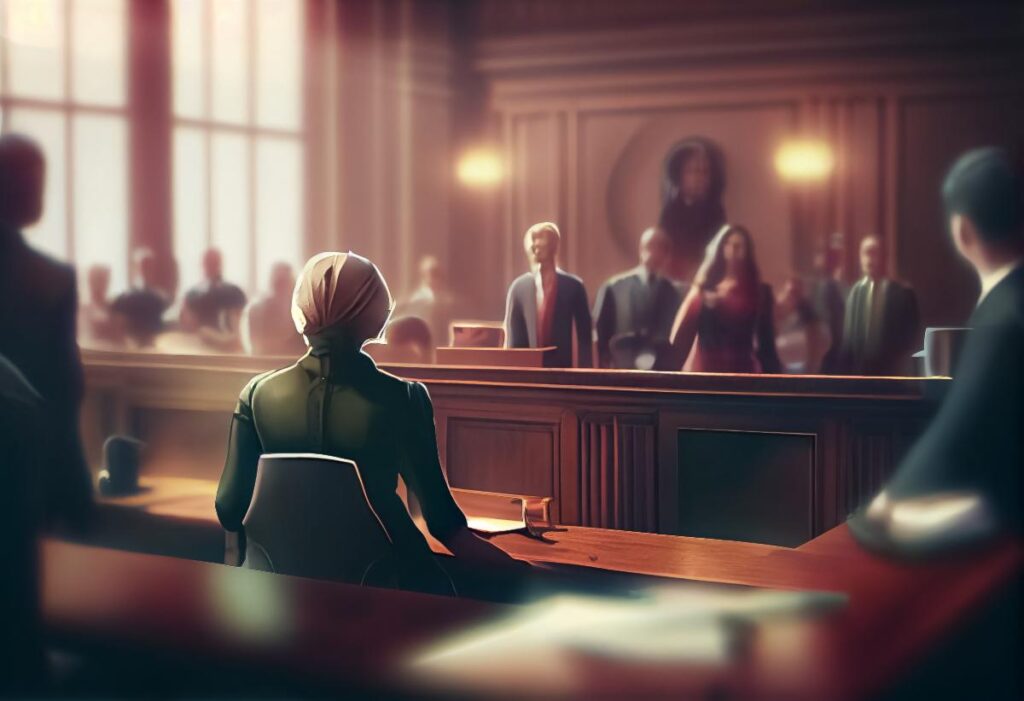
| a series by Dick Fichter, Parishioner with support from Rev. Dina, Rector March 13, 2024 |



| The following contains substantial portions from an article by Professor Doug Linder on the Famous Trials Website, The Trial of Jesus: An Account (2002) and also from the Living in Christ series, The Political and Religious Structure in Jesus’ Time, Saint Mary’s Press. Different Kinds of Condemnation After his condemnation by Jewish authorities, Jesus was brought by most accounts to the Roman prefect of Judea, Pontius Pilate. The reason, according to John, was that the death penalty was not an available option for the Sanhedrin under Roman law. Point of Interest: The Sanhedrin operated during these times with less than complete independence to implement Jewish law, having a dual political and religious status. There is, however, strong reason to believe that Jewish authorities could, had they so desired, executed Jesus, by stoning. Temple inscriptions from the period warn of death to Gentiles that pass into certain restricted areas. The gospels tell a larger story, seeking to express deep truths beyond the word-by-word facts. The biblical accounts of the trial before Pilate are not meant to be read like modern-day court transcriptions. According to most scholars, it is unlikely that any supporter of Jesus would have been present to record any questioning of Jesus by Pilate. A Jew would have considered it defiling to be in Pilate’s (a gentile’s) presence. The Gospels portray that Pilate was initially unpersuaded of Jesus’ guilt. For example, in Mark, after Pilate asks Jesus about “the many charges [the chief priests] bring against you,” Jesus makes “no further answer” and “Pilate was amazed.” Later, Mark reinforces his suggestion of a reluctant executioner when he writes, “For [Pilate] perceived that it was out of envy that the chief priests had delivered him up.” Finally, Mark makes Pilate’s doubts explicit by having him almost beg the crowd to release Jesus over the (almost certainly invented) prisoner Barabbas. Pilate asks the crowd to explain their thirst for the blood of Jesus: “Why, what evil has he done?” Pilate allows the crucifixion of Jesus, in the gospel accounts, not out of a conviction that Jesus did anything wrong, but only to “satisfy the crowd.” If there was still any doubt about Pilate’s doubt, the gospels report that after authorizing his execution, he “washes his hands.” The Gospel accounts so transparently attempt to present the chief priests–and not Pilate–as the more blameworthy party that scholars have raised numerous questions about their accuracy. And this orientation of focus has led to terrible persecution of Jews across history. Scholars point out that the earliest scriptures, written at a time of Roman prosecution of Christians, had incentives to present a story that would minimize the risk of condemnation by Roman authorities and maximize prospects for winning converts to Christianity from among the Romans. Pilate was a powerful figure. If he had reservations about killing Jesus, he certainly could have taken him back to Caesaria for trial or referred his case back to the Sanhedrin for possible punishment under Jewish, not Roman, law. The fact that Pilate did not do so suggests that he was pleased to accede to the urgings of Jewish leaders and crucify Jesus. Anyone calling himself “King of the Jews” would have been seen as trouble by Roman officials. Trials or Not It is altogether possible that there not only was no trial before the Sanhedrin, but none before Pilate either. Pilate and Caiaphas worked long–and probably, therefore–and well together. They very likely might have had standing arrangements for dealing with subversive action during festival time. These arrangements could have included, according to Biblical scholar John Crossan, “instant punishment with immediate crucifixion as a public warning and deterrent.” Crossan argues, “There would be no need to go very high up the chain of command for a nuisance nobody like Jesus, no need even for a formal interrogation before Caiaphas, let alone a detailed trial before Pilate.” Ehrman agrees, writing, “If someone was perceived to be a troublemaker, there was no need to follow anything that would strike us as due process, at least for the non-Roman citizens of the provinces.” Ehrman adds, “There would have been no reason to conduct a criminal investigation out in the open and ask for the crowds’ opinions.” Pilate had little concern for Jewish sensibilities and likely detested everything about the Jewish people. During his ten-year tenure (from 26 C.E. to 36 C.E.) as prefect, Pilate had numerous confrontations with his Jewish subjects. According to Jewish historian Josephus, Pilate’s decision to bring into the holy city of Jerusalem “by night and under cover effigies of Caesar” outraged Jews who considered the images idolatrous. Pilate provoked another outcry from his Jewish subjects when he used Temple funds to build an aqueduct. His lack of feeling was accompanied, according to Jewish philosopher Philo writing in 41 C.E., by corruption and brutality. Philo wrote that Pilate’s tenure was associated with “briberies, insults, robberies, outrages, wanton injustices, constantly repeated executions without trial, and ceaseless and grievous cruelty.” Philo may have overstated the case, but there is little to suggest that Pilate would have any serious reservations about executing a Jewish rabble-rouser such as Jesus. Jesus’ Arrest and Conviction As noted in the Oxford Bible commentary, the account of Jesus’ trial before the Jewish authorities is one where the historical questions of what actually happened are most acute and almost intractable. The story as it stands gives rise to innumerable historical difficulties. Above all, there is the fact that Mark seems to think of the events described as some kind of formal trial resulting in a death sentence, and yet the authorities seem to have broken a large number of their own rules in conducting a capital trial in the way described. Our evidence for such rules mostly from the Mishnah — is admittedly from a later time but infringements implied here include holding a trial on a feast day, not having a statutory second session on the following day to confirm the sentence, Jesus being condemned to death for blasphemy yet technically he has not blasphemed (Mark 14:64). Some of these problems are resolved if one takes the event as less of a formal trial and more of an informal hearing as is implied by Luke’s account (which may be independent of Mark here) and also by John’s and then one jettisons the Markan chronology which implies that all things happened on Passover itself. Caveat: this has been a problem with placing events described historically (or someone’s opinion of what happened historically), which may be from a completely different time period, and not in Jesus’ time (about 33 years). The Significance of Crucifixion Most people today associate crucifixion with Jesus’ death. The cross on which Jesus died has become a major symbol of Christianity. In the ancient world, however, crucifixion was used as a punishment in many societies. It was practiced by the Romans as a cruel and terrorizing method of punishment that was meant to serve as a warning and keep people in line. In the Roman method of crucifixion, the victim was tied or nailed to a wooden cross. The victim often remained alive for several days, all the while enduring terrible pain. The actual cause of death was often asphyxiation; when the victim no longer had the strength to hold up his body, he would slump down, and his breathing would be cut off. Jesus was just one of thousands of people killed by crucifixion in the ancient world. The Gospels report the Roman custom of breaking the victim’s legs (ensuring that the victim could no longer hold up his body) in order to speed up death. Jesus’ legs were not broken, as he was already dead when the Roman soldiers came (see John 19:31–33). The Roman practice also shamed and humiliated the victim in every way. The victim was often tortured first and then stripped naked before crucifixion. The Gospels record how the Roman soldiers tortured Jesus, mocked him, and then stripped off his clothes before crucifying him (see Mark 15:15–20). In Roman society, the penalty was reserved mainly for criminals, rebels, and slaves; the Roman statesman Cicero simply calls it the “slaves’ punishment.” Cicero also writes that Roman citizens should not even spend time thinking about crucifixion, as it was such a degrading and unworthy way of dying. Another Roman practice was to attach to the top of the cross a sign indicating the alleged crime of the victim. The inscription on Jesus’ cross read, “Jesus the Nazorean, the King of the Jews,” written in Hebrew, Latin, and Greek (John 19:19–20). This refers to the fact that Jesus was crucified as the Messiah, one who claimed to be the king sent by God to rule over the Jewish People. Today you might see “INRI” at the top of a crucifix: these letters represent the Latin translation of the inscription Iesous Nazarenus Rex Iudaeorum (“Jesus of Nazareth, King of the Jews”). Crucifixion in the Roman Empire was thus understood as a great source of shame, a punishment given only to the lowest criminals and slaves. So, when the early Christians taught that their Lord and Savior had been crucified, most people must have thought the Christians were crazy for worshipping a man who had been shamed in this way. The Apostle Paul writes, “We proclaim Christ crucified, a stumbling block to Jews and foolishness to Gentiles” (1 Corinthians 1:23). It was a stumbling block for most Jews because a common Jewish expectation of the Messiah is that he would be a great military leader who would drive out the Roman oppressors—it was inconceivable that God’s chosen Messiah would be crucified. The Gentiles too would have had a difficult time believing that any kind of savior or honored religious figure would be crucified. Next week: Pilate’s action and that of the crowd. |

Do you have any questions for the Camel? Questions about God, or Jesus, or the Church? About how to be Christian? Submit them via email to clergy@epiphanyec.org. Your name will be kept anonymous.
And a response will show up in a future Hump Day Message!

| God Loves You. No Exceptions. Wednesday Night Lentent Compline Continues TONIGHT! Over Zoom Join at 7pm using Link: https://us02web.zoom.us/j/87879091376?pwd=LytDUmx2d2t4azA3TXRYL3lFeGs5dz09 Wednesday: 3/13 Wednesday: 3/20 |
| Holy Week Schedule 3/24 – 3/30 3/24 – Palm Sunday 3/28- Maundy Thursday – Holy Eucharist and Foot Washing in Nave & Stripping of the Altar: 7 p.m. 3/29 – Good Friday – Service in Chapel: 12 p.m.; Service in Nave: 7 p.m. 3/30 – Holy Saturday – Short said service in Nave: 10 a.m. Decoration of church for Easter Sunday 10:15 a.m. Easter Sunday! 3/31 Worship at 10am, Flowering the Cross before and Egg Hunt follows. |


